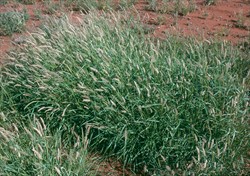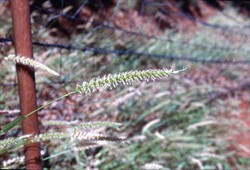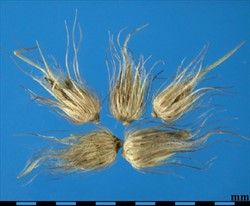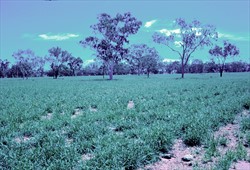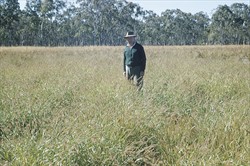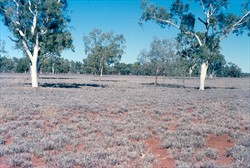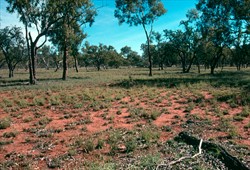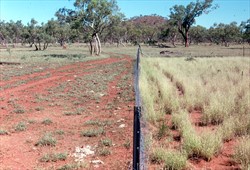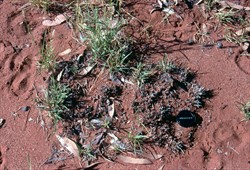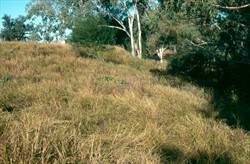Cenchrus pennisetiformis
Tropical Forages
Cenchrus pennisetiformis Hochst. & Steud.
Pennisetum pennisetiforme (Hochst. & Steud.) Wipff
Family: Poaceae (alt. Gramineae) subfamily: Panicoideae tribe: Paniceae subtribe: Cenchrinae.
Annual or perennial (sometimes short-lived) tussock. Culms erect or geniculately ascending to (20–) 40–60 cm tall and to 80 cm at maturity, similar to smaller - medium types of C. ciliaris. Leaf sheath compressed, keeled, margins ciliate; ligule reduced to a ciliate fringe. Leaf blade convolute or flat, linear, to 20 cm long and 5 mm wide; glabrous to pilose, scaberulous. Inflorescence a pale beige to purplish spiciform panicle, 2–6 (–9) cm long and c. 1 cm wide, with numerous bur-like seed units (fascicles) inserted along a zigzag axis. Fascicle comprising 1–5 spikelets, 4–5.5 mm long, ovate to acutely lanceolate, surrounded by an involucre of bristles; involucral bristles deciduous with the fertile spikelets; with an outer whorl of thinner bristles; inner bristles longer than outer; with one conspicuously longer bristle; 8–16 mm long; bristles antrorsely barbed and hairy, giving the fascicle an adhesive quality. Caryopsis obovoid; dorsally compressed; 1.5–2 × 1 mm; dark brown; glabrous; truncate, or obtuse; apex unappendaged. 400,000 seed units/kg.
Similar species
C. ciliaris: inner bristles of the involucre united at the base only.
C. pennisetiformis: inner bristles of the involucre united for 1–3 mm above the base.
Africa: qoncorro (Borana, Kenya); k'onc'orro (Gabra, Kenya); garrao (Somalia)
English: Cloncurry buffel, white buffel, slender buffel grass (Australia)
India: dhamanio
Pakistan: dhaman gaa; lidder (also applied to C. biflorus); sitti
Native:
Africa: Ethiopia; Kenya; Somalia; Sudan
Asia: India; Iran; Pakistan; Yemen
Naturalized:
Australasia: Australia (Northern Territory, Queensland, South Australia, Western Australia)
Forage
Primarily for permanent pasture. Valuable standover feed in low-rainfall areas as it remains green well into the dry season.
Environment
It can be used for stream bank protection in rivers and creeks.
Other
Being investigated for antifungal properties of foliar extracts.
Soil requirements
Prefers sandy soils, loams and alluvial silts, but does not extend onto heavy cracking clays. Best on fertile soils with high phosphorus and calcium levels, and pH >7. In Australia, it has spread from river alluvium to frontage woodlands and stony, undulating country beyond.
Moisture
Although mostly naturalized in the 370‒560 mm annual rainfall zone in northern Australia, it is found in dune-land in central Pakistan where the annual rainfall ranges from 130 to 180 mm, with a long dry season. Excellent drought tolerance, remaining green during the dry season. However, extended severe droughts can kill plants. Survives seasonal flooding.
Temperature
Best adapted between 20° N and S latitudes and from sea level to 400 m asl. Grows in hotter areas than C. ciliaris (average temperature range: 10‒30°C). Rated as moderately frost tolerant in Australia (leaves burnt but most plants recovering with onset of rain and warm conditions). However, native stands in central Pakistan are found in areas where summer temperatures can be as high as 52 ºC, and below 0 °C in winter.
Light
Grows in partial shade along river banks and under larger trees, as well as in open country.
Reproductive development
An early flowering short day plant. Flowers February‒April and again August‒October in Madhya Pradesh, India (latitude 21.2°‒26.87° N)
Defoliation
Grazed early in the growing season, allowed to seed, and then stocked again to help spread the seed.
Fire
Recovers well following fire.
Guidelines for establishment and management of sown forages.
Establishment
Similar post-harvest dormancy to C. ciliaris and C. setiger. Needs some soil disturbance for establishment. Normally broadcast over a single light cultivation and around large trees, edges of roads and cattle tracks. Good seedling vigour. Establishes readily after flooding disturbance beside fertile water courses.
Fertilizer
It has been observed that C. pennisetiformis flourishes around the bases of trees where soil fertility is higher, and spreads more rapidly on alluvial soils where phosphorous levels are higher. However, while it responds to nitrogen and phosphorus, it is generally not economical to fertilize in semi-arid and arid areas.
Compatibility (with other species)
Plants are very competitive in well-suited environments. Usually grows as a monospecific sward once established.
Companion species
Grasses: There are currently no well-adapted grasses available where this species is best adapted.
Legumes: While few, if any, currently available legumes have proven adapted to the same environment as C. pennisetiformis, there may be Desmanthus spp. that can compete with this grass in some situations, e.g. D. bicornutus, D. covillei, D. virgatus[1] [2] [3].
Pests and diseases
No major pests or diseases in forages. Seed crops can be reduced by buffel grass seed caterpillars (Mampava rhodoneura Lepidoptera, Pyralidae) that feed on seed, webbing the heads together.
Ability to spread
Seed spread by wind, water movement and adhesion to livestock, mostly near watercourses where soil phosphorous levels are high and the soil surface is of a lighter texture. Gradually spreading into poorer soils.
Weed potential
Can displace less vigorous native grasses and tends to be linked with C. ciliaris in terms of threat posed to ecosystems outside its native range.
Nutritive value
Approaches that of C. ciliaris.
Palatability/acceptability
Stems are soft and the whole herbage is well grazed by sheep and cattle.
Toxicity
While no toxicity has been reported, "big-head" disease of horses from Ca /P imbalance should be considered if C. pennisetiformis is the major source of forage for extended periods.
Feedipedia link
Not available.
Dry matter
Yields vary with proximity to trees, probably reflecting the higher fertility under trees due to cattle camping and litter drop. Yields of over 6 t/ha DM have been recorded under trees compared with 2‒3.5 t/ha DM away from the base of trees.
Animal production
Prime condition bullocks can be produced on vigorous stands growing on fertile river frontage soils in the semi-arid tropics.
2n = 35, 42, 54. Considered a natural hybrid between C. ciliaris and C. setigerus, most closely resembling the former.
Seeds prolifically. Seeds can be easily harvested by hand or mechanically.
No information but probably similar to those for C. ciliaris:
"Can be controlled using a combination of glyphosate and ammonium sulphate, possibly in repeat applications. Seedlings can be controlled using the grass -selective herbicide, fluazifop-p-butyl or dicamba, 2,4-D, 3,6-dichloropicolinic acid, triclopyr, tebuthiuron, or hexazinone. Older stands, particularly freshly cut material can be at least reduced using hexazinone or tebuthiuron."
- Ability to colonise the banks of streams in the dry tropics
- Good palatability compared with most other arid zone grasses
- Very drought tolerant
- Very persistent
- Maintains good ground cover preventing erosion in droughts
- Does not grow on heavy cracking clays
- Poses a weed threat in conservation areas
Bogdan, A.V. (1977) Tropical Pasture and Fodder Plants. Longman Inc., New York, USA. p. 74.
Hall, T.J. (1978) Cloncurry buffel grass (Cenchrus pennisetiformis ) in north-western Queensland. Tropical Grasslands 12:10–19. bit.ly/2UkMASv
'Cloncurry' naturalized in Australia. The origin of this ecotype is uncertain other than it was first noticed in the Cloncurry district of north Queensland in the 1920s. Possibly from seed inadvertently introduced in stuffing of Afghan camel saddles.
None reported.
